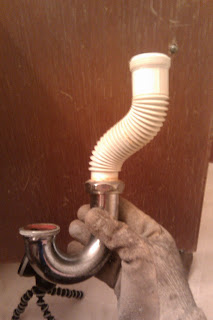 |
| The P-trap. It's not so scary, is it? |
Most slow drains are, in my experience, caused by a gradual buildup of debris. Fortunately, sinks and drains are designed to be relatively easy to clean, when needed. Every sink should have what is called a P-trap somewhere near the drain connection to the sink. P-traps prevent things from going down the drain that shouldn't. If you ever lose a ring or other jewelry in the sink, don't worry, just check the P-trap. They are also a handy access point for unclogging drains.
 |
| P-trap and wonky connector. |
In my case, I had this wonky* flexible plastic connector going from the sink to the P-trap (*not a technical term). I decided to just leave it on and remove the whole thing in one piece. I figured the clog could be in the flexible connector. Your sink setup is probably different, but I'm sure you can figure it out.
Once the P-trap is removed, the gross part begins. As I mentioned, the most likely culprit is a hairball. I had about a one-foot section of wire lying around, so I decided to fashion it into a hook to snag the hairball. It worked well because the wire is flexible, but still rigid enough to hold its shape. A wire clothes hanger would probably work well too.
 |
| I used some old wiring for a hairball hook. |
When reattaching everything, take care not to crossthread the connections. Make it tight, but not too tight. Plastic connectors run the risk of breaking if tightened too much. Also, don't tweak any of the pipes. Have a firm grip on them when using the wrench or pliers.
After you're finished, run the water for a while to admire your work (and secretly check for drips if you're trying to impress anyone).

3 comments :
Thank you! this was very helpful!
I know this is an old post but I love the weird old stuff you find in the house from previous owners. In this case the new sink was off-center so they used the flex hose which is actually prohibited in the codes [because they are terrible]. Fixing this would be tough but maybe two 45 elbows would bring it over if the trap swivels around. Either way it looks like fun. Also the reason there are traps is so the sewer gas does not leak out, even though it does make it handy to save jewelry from the black depths.
Bob A.
Thanks for the comment, Bob. This is in the apartment I rent, so I don't think I'll be spending the time or energy on trying to fix it. Does look like a bit of a project though.
Good call on the sewer gas. That purpose had never occurred to me, but it certainly makes sense. Good thing, because some would say there is already enough flammable gas around my apartment.
Post a Comment